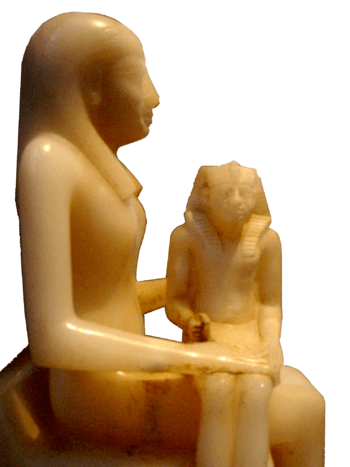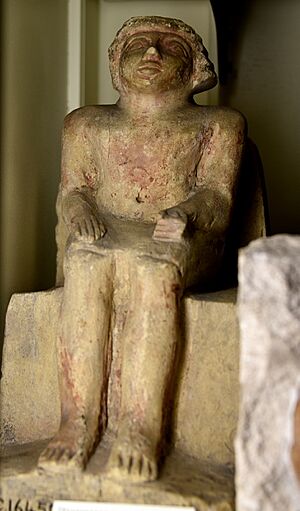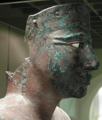Sixth Dynasty of Egypt facts for kids
Quick facts for kids
Sixth Dynasty of Egypt
|
|||||||||||
|---|---|---|---|---|---|---|---|---|---|---|---|
| ca. 2345 BC–ca. 2181 BC | |||||||||||

Ankhnesmeryre II and son Pepi II
|
|||||||||||
| Capital | Memphis | ||||||||||
| Common languages | Egyptian language | ||||||||||
| Religion | ancient Egyptian religion | ||||||||||
| Government | Absolute monarchy | ||||||||||
| Historical era | Bronze Age | ||||||||||
|
• Established
|
ca. 2345 BC | ||||||||||
|
• Disestablished
|
ca. 2181 BC | ||||||||||
|
|||||||||||
The Sixth Dynasty was a period in ancient Egypt. It was part of the Old Kingdom, which also included the Third, Fourth, and Fifth Dynasties. This dynasty ruled for about 160 years, from around 2345 BC to 2181 BC. During this time, Egypt was led by powerful kings known as pharaohs. Their capital city was Memphis, and their pyramids were built nearby in Saqqara.
Contents
Who Were the Sixth Dynasty Pharaohs?
The kings of the Sixth Dynasty are listed in the table below. Historians have different ideas about how long each king ruled. For example, the ancient writer Manetho said the dynasty lasted 203 years. But another old record, the Turin Canon, suggests it was about 181 years. These numbers can change depending on which ancient text or modern expert you ask.
| King's Name | Throne or Horus Name | Image | Approximate Dates | How Long They Ruled | Their Pyramid | Main Queens |
|---|---|---|---|---|---|---|
| Teti | (Horus) Seheteptawy |  |
2345–2333 BC | Manetho: 30–33 years Turin Canon: Less than 7 months Cattle count: 12–13 years |
Pyramid of Teti at Saqqara | Khentkaus III Iput I Khuit |
| Userkare | (unknown) |  |
2333–2331 BC | Manetho: Not mentioned, possibly involved in Teti's death Turin Canon: Might be missing |
||
| Pepi I | Nefersahor (first) Merenre (later) |
 |
2331–2287 BC | Manetho: 52 years Turin Canon: 20 or 44 years Cattle count: 49–50 years |
Pyramid of Pepi I in South Saqqara | Ankhesenpepi I Ankhesenpepi II Nubwenet Meritites IV Inenek-Inti Mehaa Nedjeftet |
| Merenre I | Merenre | 2287–2278 BC | Manetho: 7 years Turin Canon: 6 years Cattle count: 10 years |
Pyramid of Merenre in South Saqqara | Ankhesenpepi II | |
| Pepi II | Neferkare |  |
2278–2184 BC | Manetho: 94 years Turin Canon: More than 90 years Cattle count: 64–66 years |
Pyramid of Pepi II in South Saqqara | Neith Iput II Ankhesenpepi III Ankhesenpepi IV Udjebten |
| Merenre II | Merenre [Nemty?]emsaf |  |
2184 BC | Manetho: 1 year Turin Canon: 1 year, 1 month |
||
| Netjerkare Siptah or Nitocris |
(unknown) |  |
2184–2181 BC | Manetho: Nitocris for 12 years Turin Canon: Now believed to be Netjerkare, not Nitocris. |
How the Dynasty Changed Egypt
Many experts see the Sixth Dynasty as the last part of the Old Kingdom. During this time, the power of the pharaoh started to change. Religious leaders and government officials gained more influence. This trend began in earlier dynasties and continued to grow.
By the time of King Djedkare Isesi, officials were given more authority. They even built grand tombs for themselves. This led to a system where local leaders had more power. This shift in power, along with economic problems, became stronger during the Sixth Dynasty. It eventually led to a period called the First Intermediate Period, when Egypt was less unified.
King Teti's Reign
Teti was the first king of the Sixth Dynasty. He became pharaoh around 2345 BC. Historians disagree on how long he ruled. Some ancient texts say 30 or 33 years, while others suggest much shorter. Modern experts think he ruled for about 12 to 23 years.
Teti's wife, Iput, was likely the daughter of the previous pharaoh, Unas. This marriage helped Teti become king because Unas had no sons. Teti chose the name Seheteptawy, meaning "He who pacifies the Two Lands." This showed his goal to bring peace and unity to Egypt. He kept many officials from the previous dynasty to ensure a smooth transition.
Teti moved the capital city to a new area near his pyramid. He also worked with important noble families. For example, he married his daughter, Sesheshet, to a powerful official named Mereruka. Mereruka's large tomb was built close to Teti's pyramid. Teti also helped temples by making them free from taxes. He traded with lands like Byblos and Nubia.
Teti built a pyramid in North Saqqara. It was similar to the pyramids of earlier kings. Inside, the walls of his burial chambers were covered with Pyramid Texts. These were magical spells meant to help the pharaoh in the afterlife. Some ancient stories say Teti was killed by a bodyguard. This might explain why another king, Userkare, ruled briefly between Teti and Pepi I.
Pepi I's Rule
During the reign of Pepi I, Egypt sent many expeditions. They traveled to places like Wadi Maghara in the Sinai Peninsula to mine for turquoise and copper. They also went to Hatnub and Wadi Hammamat for other resources. Pepi I also sent trade expeditions to distant lands like Punt and Ebla in modern-day Syria. These trips helped Egypt get valuable goods.
Pepi II's Long Reign
The most famous king of this dynasty was Pepi II. He is known for ruling for an incredibly long time, possibly 94 years! This would make him one of the longest-reigning monarchs in history.
The Story of Queen Nitocris
Some ancient writers mentioned a queen named Nitocris. They believed she was the first female pharaoh. However, modern research suggests that her name might be a mistake in the old texts. It is now thought that the name actually refers to a male king, Netjerkare Siptah.
The Growing Power of Nobles
We learn a lot about this period from writings found in the tombs of non-royal people. For example, we know there was a plan against King Pepi I. We also have a famous letter from the young King Pepi II. He was very excited because one of his expeditions was bringing back a "dancing pygmy" from a land called Yam, south of Nubia.
These writings in non-royal tombs show that the power of the noble families was growing. This meant the king's absolute power was becoming weaker. When the very long-reigning Pepi II died, his local governors and powerful nobles had enough strength to challenge the kings who came after him. This might have been a big reason why the Old Kingdom quickly declined.
Images for kids
See Also
 In Spanish: Dinastía VI de Egipto para niños
In Spanish: Dinastía VI de Egipto para niños








